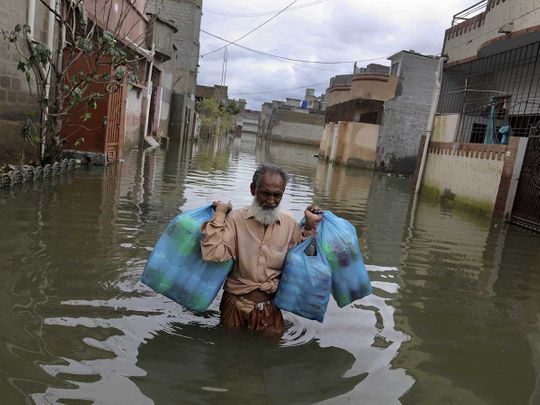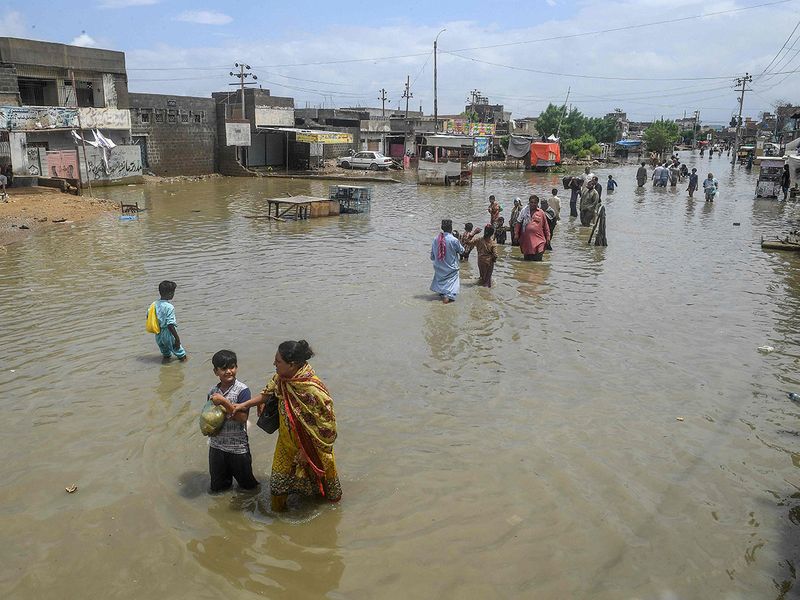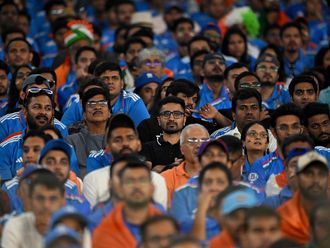
In August in Karachi:
A white-bearded man wearing a white prayer cap holding a tiny black bag is wading in muddy brown water, peppered with garbage of various forms and sizes. The dull backdrop of his journey in water are blocks of nondescript apartments. On one side of the double road, partly partitioned with an iron railing, is what looks like a tiny cluster of shanties. There is no other human in sight.
The stillness of the photo is an eerie replication of the anguish of the half-submerged man.
In one video, four men are seated in a car in which muddy brown water reaches up to the steering wheel. One of them is giving a running commentary: “Right now, we’re, mashAllah, enjoying Karachi. Look at our car. And this view of a lake, a pool, mashAllah. [People are] pushing, the car has stalled. This will be our memorable journey. I’m sitting on the side. This is the situation. Bhutto zinda hai jee, Bhutto zinda hai (Bhutto is alive–the slogan of PPP, the party in power in Sindh for more than a decade).
In one video, muddy brown water has flooded an entire colony. People are chest deep in water that moves in an angry motion as it sees no place for its escape.
In a viral video, a human chain is pulling a police vehicle tied to a rope. Stuck in the middle of one stretch of Shahrah-e-Faisal, reportedly the most flooded part of Karachi, the image is a reflection of the beautiful humanity of Karachi and the utterly dismal ineffectiveness of Karachi’s local body departments.
One person tweeted: “Abbu was on his way back from work and got stuck at Safura after driving over a broken manhole hidden in water, which burst two of his car's tires. I had to reach him through 2-3 feet of water, take the wheels off, take them to a tyre shop. Carry them all the way back through the water, change the tyres and then drive back home through all that water. Allah ka shukar hai, the engine didn't seize even though at one point the water level was almost to the car's bonnet. I'm so glad he was close enough. To the house (3-4kms) that I could walk over and help him out. Had he been stuck further God knows how he would've gotten home. This is just one story out of millions of stories that people will be going through today. I hope all of them reach their homes soon.”
One person tweeted: “My uncle in Karachi had a heart attack this evening and relatives and neighbours tried everything from trying to drive him to physically carrying him on their shoulders to get to the hospital, but they couldn’t make it on time, and he passed away.”
One person tweeted:” City of lights, city of dreams, city that acts as a mother to our country, Karachi is in crisis. It's drowning, people jumping from rooftop into underpass, who could have thought of this. It may sound funny but it's not. Karachi needs help.”
One person tweeted: “No electricity. No gas. No drinking water. Waterlogged streets. Trash everywhere. No mobile networks. But I love my city Karachi. Need prayers.”
One person tweeted: “It's been 24 hours & above since my house was flooded. Not a single government or local official, army, NDMA official have come to help us. There is two feet of water in our homes for a day now & no respite whatsoever. I am asking again. CAN ANYONE HELP US?”
Countless tweets, images and videos of Karachi’s unprecedented torrential rains dot my Twitter timeline like unstoppable tears and wails of agony, frustration, anger, despair. 84 mm of rain in the earlier part of Friday lashed parts of Karachi. On Friday, for more than 29 hours at a stretch, the low-income, middle class and elite Karachi was without electricity. On Saturday, some areas have electricity after 53 consecutive hours. Infrastructure of cellular companies is disrupted, making it impossible for people to contact their families as they remain stuck in rainwater that has flooded many major roads in various areas.
The havoc wreaked
Rain devastation is also merciless to retail and industrial activities of Karachi. 20-50 percent of its total capacity was affected “as workers were absent from their respective units while many returned home after 2pm as rains flooded many areas and main arteries of the city.”
The poshest to the low-income localities, the havoc of rainwater is indiscriminatory. Homes of millions of people are flooded. DHA and Surjani are reportedly the most affected parts of Karachi. Low-lying slums are waterlogged. Almost all underpasses are fully inundated, every underpass a silent, swirling long rectangular of muddy brown water. On almost every rain-ravaged road cars, motorcycles, vans, rickshaws, submerged in water, bob like paper boats of a child. Containers, placed on some roads for easy movement of Moharram processions, float as if weightless. Boats are being used on some roads for rescue and transportation.

As roads are flooded, life for millions of people is at a standstill. Availability of necessities is compromised: food, water, emergency healthcare, fuel.
The most heart-breaking tragedy of the rain devastation in Karachi is the human loss. Drowning, electrocution, structures collapsing. Precious lives lost, captured in the terseness of agonised tweets, newspaper headlines, TV tickers.
“A lifeless man lying in rainwater, his legs caught under the weight of his bike. Possibly electrocuted. No one knows how long he had been there. Call made to ambulance service. Please don’t go out in rain.”
“Inna lillah e wa inna ilaihe rajioon. Stuck at Shahrah-e-Faisal, near Stargate since 1pm. No movement. Water inside the car. Cars and bikes inside water. An old uncle just expired in black Corolla AUY 788. Phone almost dead. Help anyone. Fwd as much as u can.”
“Heartbreaking” was the caption of a TV news report in three screenshots: “Houses in PECHS flooded. A polio-affected woman was wheelchair bound. The woman drowned in the water in her own home.”
“Among those who lost their lives in the catastrophic #KarachiRain yesterday: residents of Niaz Manzil, Khizar and Maria, their daughter Fatima and their young son. 18-year-old Noman, a resident of Patrus Garden.”
At Saima Square 1 Apartments, four children Hassan (10), Hussain (12), Rafiq (14), and Abdul Rafay (14) died when a wall collapsed. Four children dead due to rainwater devastation.
Dawn reported: “The body of an unknown man was found floating in a stream near football chowk in Hawkesbay.
The body of an unknown man, in his 40s, was recovered from a nala (drain) in North Nazimabad.
The body of an unidentified man in his mid-20s was found floating in Korangi Crossing nadi.
21-year old Taimur Yaqoob drowned in a drain in Manzoor Colony.”
On August 29, reportedly, the number of Karachi’s dead is 40. May Allah give their families strength. No words of condolence would suffice.
Any estimate of material loss–personal and public–is impossible at this point.
In August, Karachi has had 442 mm of rainwater. It was 53 years ago in July 1967 that Karachi faced 429 mm rain. The monsoon of 2020, so far, has unleashed 566 mm of rainwater. The monsoon of 2020 is reported to have the heaviest rains in the last one hundred years.
Media reports that despite constant warnings of urban flooding, arrangements remained inadequate. The consequence is catastrophic.
PTI’s Karachi parliamentarians shrug in helpless powerlessness. Between the blame games of the party in power in Sindh, PPP, and the party in power in Karachi, MQM, it is Karachi, the city of almost 15 million people and Pakistan’s financial hub, that is in unquantifiable pain today.
Unsung heroes
The heroes of Karachi are not its political elite, elected parliamentarians, tone deaf politicians. The heroes of Karachi are the nameless, faceless workers of Edhi Foundation, Al-Khidmat, Chippa, and many other philanthropic organisations and NGOs. Pakistan salutes them all.
Working side by side these unsung heroes is the Pakistan Army and Rangers. Their unassuming social work continues, in rain, in sunshine, in flood, in hurricane.
In its Global Livability Index 2019, the Economist Intelligence Unit named Karachi as one of the 10 least livable cities in the world. Nothing changed in Karachi after that dire proclamation.
Beyond climate change and unprecedented rain, there are several factors in play for which only humans of Karachi are responsible: unplanned tremendous expansion in the last three decades; absence or blockage of roadside drainage channels; illegal settlements constructed on or close to major drainage lines obstructing the flow of water; abysmal waste disposal system; obstruction of drainage lines due to unchecked garbage dumping; inefficient solid waste removal; clogged waterways; infrastructural insufficiencies; clogged nullahs.
On August 27, Prime Minister Imran Khan tweeted: “My govt is fully cognizant of the suffering of our people in the wake of the heavy rains, especially the people of Karachi. I am personally monitoring the relief & rescue operations & am in constant contact with Chairman NDMA & Governor Sindh for regular updates. Have directed Chairman NDMA to immediately not only rescue stranded ppl, but also provide emergency medical assistance, food & shelter to all those in need. I have also asked NDMA Chairman to ensure restoration of utilities on an emergency basis. We will be announcing a plan for a permanent solution to the problems caused by floods by cleaning of nullahs, fixing of the sewage system & resolving the huge challenge of water supply to the ppl of Karachi. We will not abandon the people of Karachi in their time of crisis.”
Prime Minister Khan in a telephonic call to Sindh Chief Minister Murad Ali Shah of PPP said that he would be visiting Karachi next week, adding, “I will sit with you to draw up a complete plan to help Sindh government.” According to Dawn, “Chief Minister Shah thanked the prime minister for calling him and offering assistance.”
On August 29, Prime Minister Khan tweeted: “The whole nation feels the pain our people in Karachi are going through. However, out of this devastation & suffering there is now a positive development as my govt, along with the Sindh govt, is moving to immediately act & resolve 3 major problems of Karachi: cleaning the nullahs once & for all & dealing with encroachments impeding water channels; devising a permanent solution to the solid waste disposal & sewerage problems; & resolving the critical issue of water supply to the citizens of Karachi.”
Will Karachi be saved? Time will tell.
Today, Karachi is sinking. Karachi is in a quiet monologue in its watery darkness. Karachi is smouldering. Karachi is watching its ghoulish decay.
Listen to Karachi’s simmering silence before Karachi erupts.








